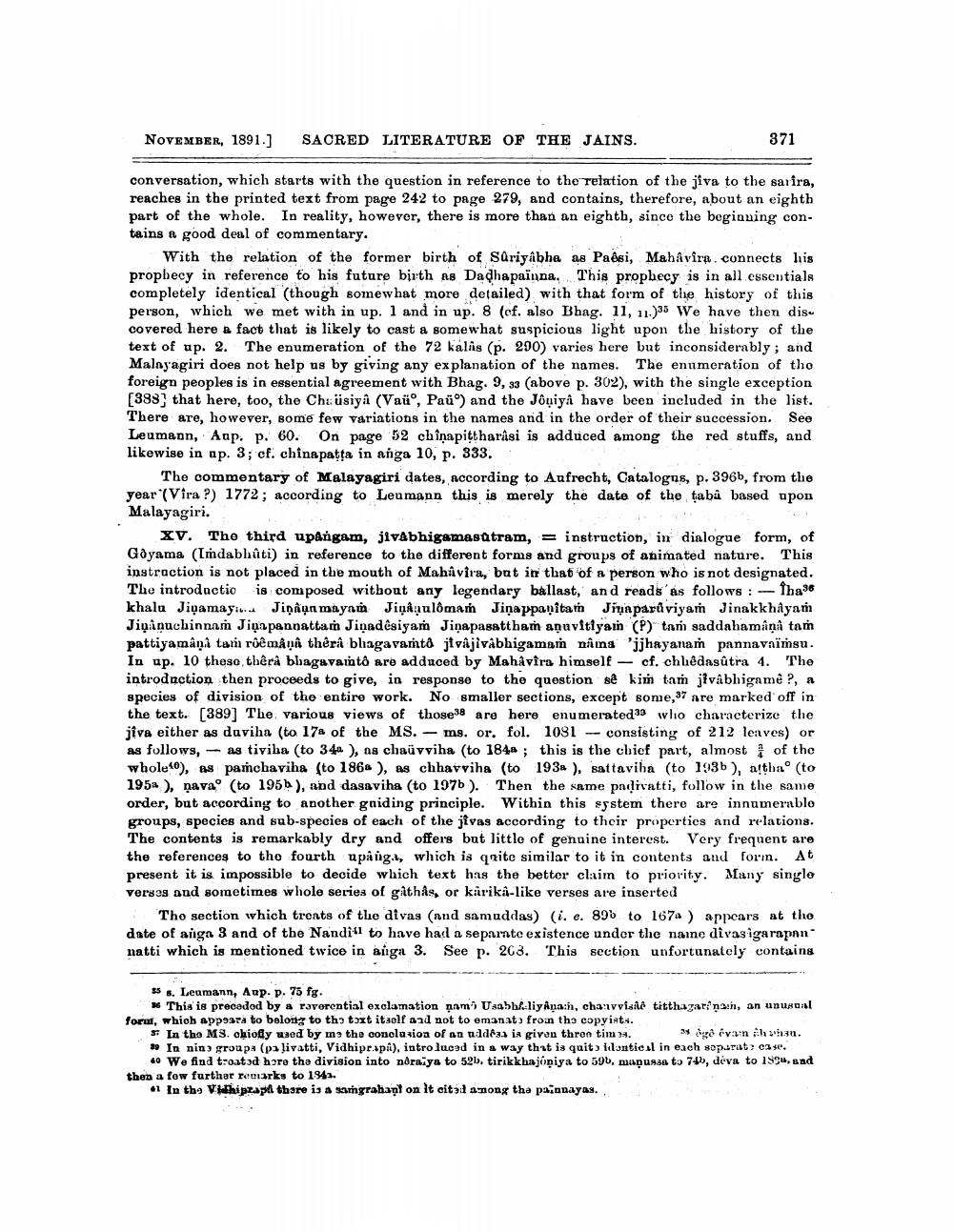________________
NOVEMBER, 1891.)
SACRED LITERATURE OF THE JAINS.
371
conversation, which starts with the question in reference to the relation of the jiva to the salira, reaches in the printed text from page 242 to page 279, and contains, therefore, about an eighth part of the whole. In reality, however, there is more than an eighth, since the beginning contains a good deal of commentary.
With the relation of the former birth of Suriyabha as Padsi, Mahavira. connects liis prophecy in reference to his future birth as Dadhapažnna. This prophecy is in all essentials completely identical (though somewhat more detailed) with that form of the history of this person, which we met with in up. 1 and in up. 8 (cf. also Bhag. 11, 11.)35 We have then disa covered here a fact that is likely to cast a somewhat suspicious light upon the history of the text of ap. 2. The enumeration of the 72 kalis (p. 290) varies here but inconsiderably; and Malayagiri does not help us by giving any explanation of the names. The enumeration of tho foreign peoples is in essential agreement with Bhag. 3, 33 (above p. 302), with the single exception [388) that here, too, the Cheüsiya (Vaüo, Paü) and the Jöniya have been included in the list. There are, however, some few variations in the names and in the order of their succession. See Leumann, Aap. p. 60. On page 52 chînapittharasi is adduced among the red stuffs, and likewise in ap. 3; cf. chinapata in anga 10, p. 333.
The commentary of Malayagiri dates, according to Aufrecht, Catalogus, p. 396b, from the year (Vira ?) 1772; according to Leumann this is merely the date of the tabà based upon Malayagiri.
xv. The third upangam, jivabhigamasutram, = instruction, in dialogue form, of Göyama (Imdablûti) in reference to the different forms and groups of animated nature. This ingtraction is not placed in the mouth of Mahavira, bat ir that of a person who is not designated. The introductio is composed without any legendary ballast, and reads as follows:- Tha36 khalu Jiqamayi... Jiņaạn mayam Jiņânulôman Jiņa ppanitam Jiyaparůviya Jinakkhiyam Jiņinuchinnam Jiwapannattam Jinadesiyam Jinapasattham aņuvitiyain (P) tan saddahamiņa tan pattiyamâņi tan rồêmânâ thêrî blagavamtê ji vâjivabhigamam nama 'jjhayanaṁ pannavaïmsu. In up. 10 these thêrà blagavaitô are adduced by Mahåvira himself - cf. chlêdasútra 4. The introduction then proceeds to give, in response to the question sê kim tam jivabhigame?, a species of division of the entire work. No smaller sections, except some,37 are marked off in the text. [389] The various views of those38 are here enumerated 39 wlio characterize the jiva either as duviha (to 17a of the MS. - ms. or. fol. 1081 -- consisting of 212 leaves) or as follows, -as tiviha (to 34a ), as chaüvviha (to 1848 ; this is the chief part, almost of the wholeto), as pamchaviha (to 1864 ), as chhavviha (to 1932 ), sattaviha (to 1936), a!thao (to 1952 ), navao (to 1951), and dasaviha (to 1976). Then the same pndivatti, follow in the same order, but according to another guiding principle. Within this system there are innumerable groups, species and sub-species of each of the jivas according to their properties and relations. The contents is remarkably dry and offers but little of genuine interest. Very frequent are the references to tho fourth a paig., which is quite similar to it in contents and forin. At present it is impossible to decide which text has the better claim to priority. Many single verses and sometimes whole series of gathås, or karika-like verses are inserted
Tho section which trents of the divas (and samuddas) (i. e. 890 to 1674 ) appears at the date of aiga 3 and of the Nandill to have had a separate existence under the naine divas igarapan natti which is mentioned twice in anga 3. See p. 203. This section unfortunately contains
55 s. Leumann, Aap. p. 75 fg.
* This is preceded by a reverential exclamation nami Usa5bf-liyana:n, chauviske titthagar:non, an unusoal forul, which appear to belong to tho toxt itself and not to emanatfrom the copyistu. In the MS. ohiofly used by me the conclusion of an ulda is given thron tim 4.
Vidhipropi), intro luced in a way that is quit) Idlantical in each soprat, case. 40 We find t:oated here the division into noraiya to 52b. tirikkhajóniya to 596, mapussa to 745, deva to 1894, ead then a few further remarks to 1941.
1 In the Vihiprapt there is a sangrahaņl on it citada nong tha pa onayas.




